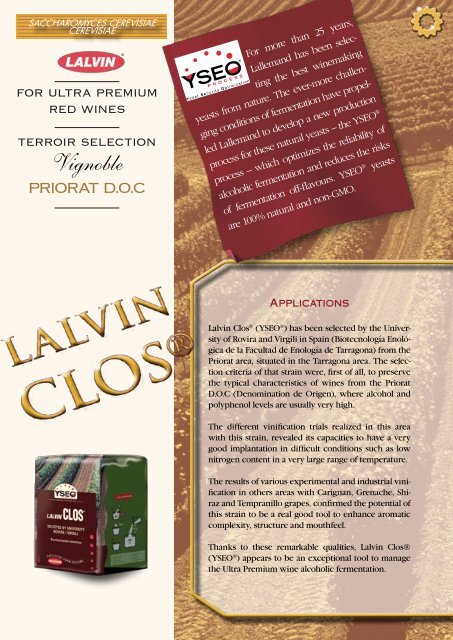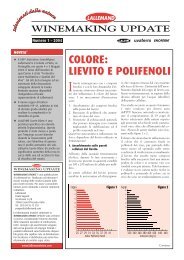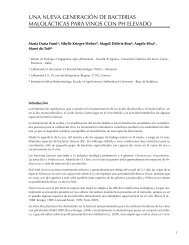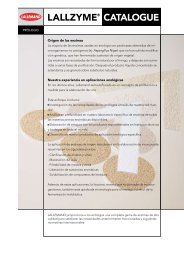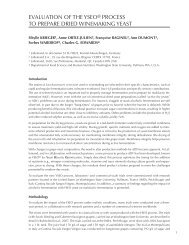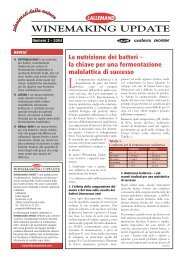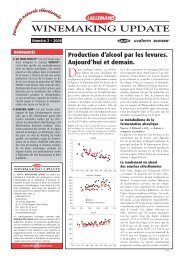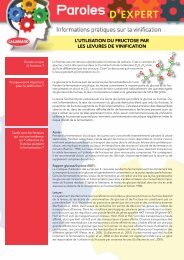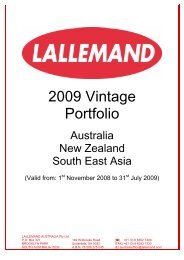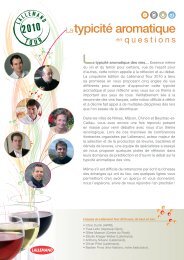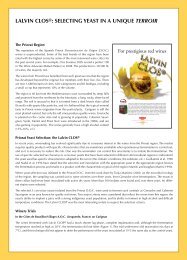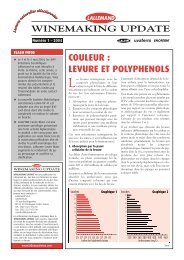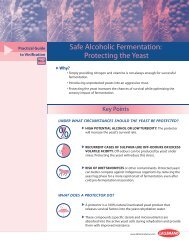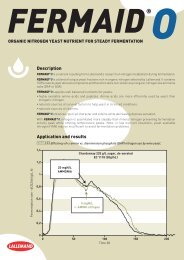Technical data sheet - Lallemand Wine
Technical data sheet - Lallemand Wine
Technical data sheet - Lallemand Wine
You also want an ePaper? Increase the reach of your titles
YUMPU automatically turns print PDFs into web optimized ePapers that Google loves.
SACCHAROMYCES CEREVISIAE<br />
CEREVISIAE<br />
FOR ULTRA PREMIUM<br />
RED WINES<br />
TERROIR SELECTION<br />
Vignoble<br />
PRIORAT D.O.C<br />
For more than 25 years,<br />
<strong>Lallemand</strong> has been selecting<br />
the best winemaking<br />
yeasts from nature. The ever-more challenging<br />
conditions of fermentation have propelled<br />
<strong>Lallemand</strong> to develop a new production<br />
process for these natural yeasts – the YSEO ®<br />
process – which optimizes the reliability of<br />
alcoholic fermentation and reduces the risks<br />
of fermentation off-flavours. YSEO ® yeasts<br />
are 100% natural and non-GMO.<br />
Applications<br />
Lalvin Clos ® (YSEO ® ) has been selected by the University<br />
of Rovira and Virgili in Spain (Biotecnología Enológica<br />
de la Facultad de Enología de Tarragona) from the<br />
Priorat area, situated in the Tarragona area. The selection<br />
criteria of that strain were, first of all, to preserve<br />
the typical characteristics of wines from the Priorat<br />
D.O.C (Denomination de Origen), where alcohol and<br />
polyphenol levels are usually very high.<br />
The different vinification trials realized in this area<br />
with this strain, revealed its capacities to have a very<br />
good implantation in difficult conditions such as low<br />
nitrogen content in a very large range of temperature.<br />
The results of various experimental and industrial vinification<br />
in others areas with Carignan, Grenache, Shiraz<br />
and Tempranillo grapes, confirmed the potential of<br />
this strain to be a real good tool to enhance aromatic<br />
complexity, structure and mouthfeel.<br />
Thanks to these remarkable qualities, Lalvin Clos®<br />
(YSEO ® ) appears to be an exceptional tool to manage<br />
the Ultra Premium wine alcoholic fermentation.
MICROBIOLOGICAL AND OENOLOGICAL PROPERTIES<br />
• Saccharomyces cerevisiae var. cerevisiae<br />
• Killer factor<br />
• Very high tolerance to alcohol: up to 17%<br />
• Short lag phase<br />
• Fast and regular fermentation rate<br />
• Large tolerance temperature range:<br />
13 to 35°C<br />
Trial comparative with<br />
in high sugar content must<br />
Red winemaking: 25 to 40 g/hL<br />
• Very low requirement in assimilable<br />
nitrogen<br />
• Low production of volatile acidity<br />
• High resistance to SO 2<br />
• Good compatibility with malolactic<br />
fermentation<br />
Bellmunt de Priorat (D.O. Priorat). Grenache 2008 (Brix: 26,3; pH: 3,43; AT: 2,9 g/L).<br />
Density<br />
1120<br />
1100<br />
1080<br />
1060<br />
1040<br />
1020<br />
1000<br />
980<br />
960<br />
940<br />
920<br />
1 2 3 4 5 6 7 8 9 10<br />
Days<br />
30<br />
25<br />
20<br />
15<br />
10<br />
5<br />
0<br />
T°C<br />
Density<br />
Lalvin Clos ®<br />
Density<br />
control<br />
Temperature<br />
Lalvin Clos®<br />
Temperature<br />
control<br />
DOSAGE<br />
INSTRUCTIONS FOR USE<br />
1°/ Rehydrate in 10 times its weight of water (temperature between 35 and 40°C).<br />
2°/ Dissolve carefully by gentle stirring and wait for 20 minutes.<br />
3°/ Add to the must. The temperature difference between the must to be inoculated<br />
and the rehydration medium should never be over 10°C (if any doubt, please contact<br />
your supplier or <strong>Lallemand</strong>).<br />
4°/ The total rehydration duration should never exceed 45 minutes.<br />
5°/ It is essential to rehydrate the yeast in a clean container.<br />
6°/ The rehydration in must is not advisable.<br />
Bibliographic references<br />
Mineral<br />
3,5<br />
3<br />
2,5<br />
2<br />
1,5<br />
1<br />
0,5<br />
0<br />
• Ecología de levaduras. Selección y adaptación a fermentaciones vínicas. María Jesús Torija Martínez. Tesis doctoral<br />
dirigida por Albert Mas Barón, Nicolás Rozès. Universitat Rovira i Virgili (2002).<br />
• Torija, M.J., Rozés, N., Poblet, M., Guillamón, J.M., Mas, A. (2001). Yeast population dymanics in spontaneous fermentations:<br />
Comparison between two different wine-producing areas over a period of three years. Antonie Van<br />
Leeuwenhoek.<br />
Acidity<br />
Mouthfeel<br />
Dryness<br />
Structure<br />
Volume<br />
Fruity<br />
Vegetal<br />
Spicy<br />
Alcoholic<br />
8 professionals tasting results after AF<br />
Lalvin Clos®<br />
Control<br />
The information herein is true and accurate to the best of our knowledge however this <strong>data</strong> <strong>sheet</strong> is not to be considered as a guarantee expressed or implied or as a condition of sale of this product.<br />
Natural solutions that add value to the world of winemaking<br />
Distributor<br />
B.P. 59<br />
31702 Blagnac CEDEX<br />
tel : +33(0)5 62 74 55 55<br />
fax : +33(0)5 62 74 55 00<br />
@<br />
www.lallemandwine.com


